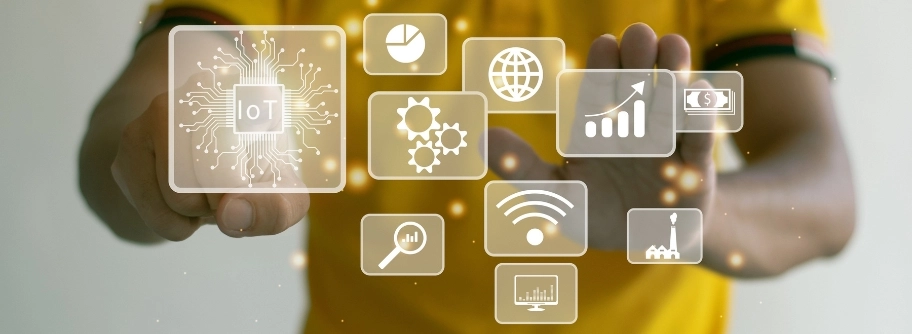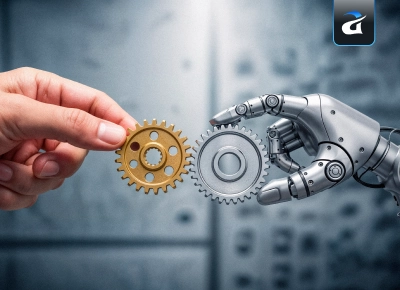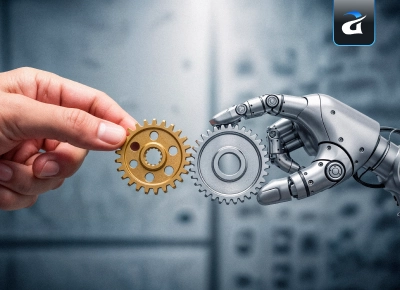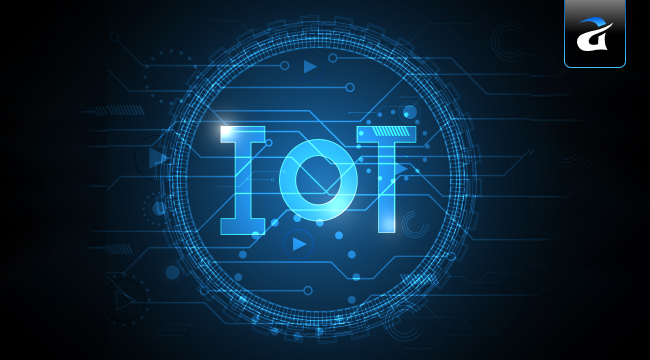So, let me be the one to break it to you that you wouldn’t be making these commands if it weren’t for IoT—which means Internet of Things. So, tell me, do you know where this technology originated and how it worked at first and then evolved into one of our most desirable pieces of comfort?
Let’s learn everything from the beginning to how IoT turned into a game-changer.

Early History of IoT and the First Connected Devices
The Idea Begins (1980s–1990s)
- IoT's history can be traced back to the 1980s and 1990s, when the technology was in the making.
- With the enhancement of computer networks and processing power, a few scientific minds started to ponder whether or not machines can actually converse with one another without human assistance.
The Term “Internet of Things” Is Born (1999)
- The year 1999 was marked by the introduction of the term Internet of Things by the British tech genius, Kevin Ashton.
- He demonstrated the potential of RFID (Radio Frequency Identification) technology to the extent that it could enable computers to recognize and monitor physical items without any manual intervention.
- This made it possible for machines to “detect” the physical environment around them, and then relay the info through the network, which was an essential factor in the evolution of present-day IoT technology.
The First Real IoT Experiment
- One of the earliest working IoT devices was a Coca-Cola vending machine at Carnegie Mellon University.
- The machine was connected to the internet and could report:
- Whether the drinks were cold
- It may sound simple today, but it proved that a device could send real-time information without human input.
Why It Mattered
- These early ideas and experiments moved IoT from theory to reality.
- For the first time, everyday objects could:
- Communicate over a network.
- Operate without direct human involvement.
- This became the foundation of today’s interconnected world—from smart homes to industrial automation.
Growth of IoT in the 2000s: From Idea to Real-World Technology
Before the 2000s we had IoT, but on paper only, so the 2000s were the years when IoT was brought to practical use. The speed of the internet quickened; Wi-Fi became a dime a dozen, Bluetooth got better, and even low-cost sensors were created.Now, with the help of these changes, the idea of devices communicating with one another went from being a probable theory to a possible phenomenon because, for the very first time now, everyday objects could collect information, process it, and send it across a network.
This change moved IoT out of research labs and into real products:
- Smart Home Devices: Devices like thermostats, security systems, lighting controls, and appliances, began entering consumer markets.
- Wearable Technology: The initial fitness trackers and smartwatches showed us how IoT could monitor health and movement.
- Industrial IoT: It started taking shape as companies used connected systems to:
- Detect faults early.
- Track assets across factories and warehouses.
- Improve production accuracy and reduce manual effort.
This decade is considered IoT’s turning point—the moment it left the stage of “future possibility” and became part of daily life. It set up the foundation for the smarter environments we see today, including intelligent homes, connected vehicles, and early versions of smart cities.
IoT Innovation in Daily Life and Smart Homes
As you can see, a myriad of tech companies has started to come up with many fascinating IoT solutions, which have indeed become a crucial part of our daily life. The home features voice assistants Alexa, Siri, and Google Assistant, which enable users to operate lights and appliances and play music and set alarms through voice commands.The systems operate through network connections to perform various tasks independently.
Inside the home, IoT appliances brought automated functionality to residential spaces:
- Refrigerators keep track of items stored in them and send an alert if groceries finish.
- Smartphones can control ovens and washing machines.
- Smart thermostats can make adjustments to temperature depending upon time, weather, and user behavior.
IoT Integration Across Industries
| Industry | How IoT Works | Benefits |
| Manufacturing & Supply Chain | There are IoT sensors which: monitor machinery, keep track of inventory, detect temperature, and control production lines automatically. | Predict if any equipment is not working, decreases downtime, lowers repair costs, avoids any delay in shipping, and improves efficiency. |
| Agriculture | Soil moisture, health of crops, level of fertilizers, and changes in weather are predicted and monitored through sensors. | Water and resources are saved, quality of crops is increased, and manual workload is also reduced for farmers. |
| Healthcare | Devices that can be worn monitor heart rate, glucose, and sleep. If anything goes wrong, an immediate alert is sent. | Faster diagnosis, improved patient safety, reduced emergency response time, and better remote care. |
| Retail & Commercial | Automated checkout systems, digital pricing shelves, IoT security cameras, and sensors that track shopping patterns and shelf stock levels. | Faster shopping reduced manual work, fewer stock outs, and better understanding of customer behavior. |
Advantages of IoT Technology in a Connected World
Convenience in Daily Life
The Internet of Things enables people to perform their daily responsibilities through automated systems. The smartwatch enable users to monitor their heart rate and blood pressure and track their step count. The room temperature system operates independently to adjust the environment while the smartwatch tracks your vital signs.Efficiency and Automation in Business
The implementation of IoT technology enables businesses to execute tasks, which would otherwise require extensive manual work. The current implementation of sensors enables organizations to detect system problems and track inventory levels and generate faster results.Improved Safety and Risk Prevention
The Internet of Things enables sensors to identify dangerous situations including factory gas leaks and smoke detection and machine irregularities and environmental threats. Smart alarms in residential settings monitor both carbon monoxide levels and fire safety and electrical system performance. The system detects potential threats before they happen, which leads to fewer accidents and better protection for people and their belongings and equipment.Cost Savings and Long-Term Value
The implementation of IoT technology enables businesses to achieve cost reductions through waste minimization and production optimization, which results in enhanced service delivery. People achieve energy savings through improved control of their heating systems and lighting systems, and appliances.Modern IoT Development: Data, AI, and Smart Cities
Smart Cities
The Internet of Things (IoT) has had a significant impact, and it has been mostly positive, since it helps to control city traffic lights, notifies when garbage bins are full, and manages streetlight power depending on usage.Smart Buildings
One of the best things is that climate control in structures varies according to the presence of humans. Heating and cooling are adjusted, and people entering or exiting are monitored by security systems, while water or power leaks are detected early—thus, saving both money and trouble.Public Transportation
Transportation and personal cars are all interconnected now. They are constantly updating their locations, alerting each other to the dangers ahead, and asking for maintenance before the problem gets out of hand.Industry and Business
IoT works in factories to monitor the health of machines, as well as to track the progress of products. Sensors for temperature control guarantee the safety of food and medicines. Companies make fewer mistakes, and resource wastage is less due to better planning.A Smarter, Sustainable World
The use of IoT among cities has gradually reduced their power consumption, cut the operating costs of businesses, and made the living conditions of households safer and more pleasant. The collaboration of IoT with AI not only ensures the connectivity of the systems, but they also get to learn, think, and contribute to the world becoming a little wiser in the running.IoT in Future Scenarios
I have some great news for you. You think IoT is pretty advanced right now? But it's merely the tip of the iceberg, for more astonishing IoT innovations are on their way, including:- Zero-Touch Buying
- Internet of Bodies
- Energy-Sharing Homes
- Predictive Public Safety
- Emotion-Aware Devices
- Micro-Robots in Industries
- Self-Optimizing Agriculture
- Smart Insurance Pricing
Want to get the best IoT solution? Contact us.
Frequently Asked Questions
What is IoT and its history?
The Internet of Things enables ordinary objects, including smartwatches and cars and home appliances and sensors, to access internet connectivity for data collection and exchange. The first IoT device that resembles modern IoT technology emerged as an internet-enabled Coca-Cola vending machine during the 1980s. The term "Internet of Things" entered public usage during 1999. The internet expansion together with sensor technology advancements and sensor price reductions led IoT to become a leading technology for residential use and urban development and medical facilities and industrial production.
What is the evolution of IoT?
The Internet of Things started with simple connected devices before advancing environmental sensing machines and eventually incorporating cloud and AI systems. The technology enables smart home systems, smart city operations, and automated industrial processes through extensive networks of interconnected devices.
What are the 4 stages of IoT?
The first step of IoT devices involves data collection through sensing capabilities. The second stage of IoT involves data transmission through Wi-Fi, Bluetooth, and cellular networks. The third stage of IoT involves data processing, which occurs through cloud-based or edge-based systems. The systems execute actions through notifications and automation and machine control during the final stage.
What are the 4 types of IoT?
Smart homes and wearable devices represent the main applications of consumer IoT technology. The commercial IoT sector includes hospitals together with retail businesses and building management systems. Industrial IoT operates through manufacturing, logistics, and energy management systems. The infrastructure IoT sector enables smart city development, operates public transportation systems, traffic management, and utility services.
What are the 4 communication models in IoT?
Two devices that operate independently from human control can establish direct communication with each other. The direct path enables devices to transmit data directly to online platforms through device-to-cloud communication. The data transmission process through a local hub or router serves as device-to-gateway communication. Back-end data sharing enables cloud systems to distribute information between different applications and services.



